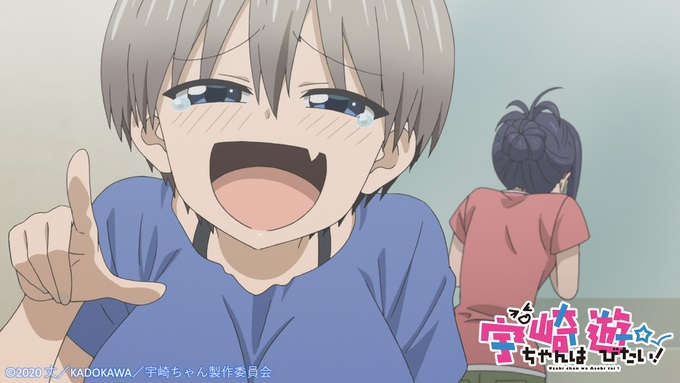
The anime “Uzaki-chan wa asobitai” recounts the experiences of Sakurai Shinichi (a third grade student at the university) whose isolated and peaceful life will be disturbed by the crazy, cute but annoying Hana uzaki (second year student of the University).
The soundtrack is composed by Satoshi Igarashi, and stands out for the variety of musical genres used to accompany the situations experienced by our characters, the use of a Polka (with ingenious variations) is very striking to represent the moments where Uzaki makes fun of Sakurai (at the movie theater or eyeglass store) or when he does some unexpected action (like signaling while Sakurai is having lunch with a friend).

The time signature of the Polka is 2/4 and it has quite a festive movement (ranging from approximately 120 bpm to more), and this time the key is in F minor (F - G - Ab - Bb - C - Db - Eb - F), which has 2 well-marked sections. The first section has the following harmony:
Fm | % | C7 | N.C. | C7 | % | Fm | N.C. | x2
We see here some “N.C.” which is short for “No Chord” (no chords), this variant is perfect, since during that moment you can play practically anything, or place a sound effect, and it will work. I am excited by the possibilities that open up when having an approach of this type in a work since it ties in very well with Uzaki’s playful personality.

Another detail that is seen is the use of the C7 Chord, since it is a chord from the Harmonic scale of Fm (F - G - Ab - Bb - C - Db - E - F). It is worth mentioning the successful treatment of the note “E” (sensitive), which being a sound that desperately resolves to “F” (Tonic), it is taken to the other sounds that make up the Fm chord (F - Ab - C), giving us a tricky sense of resolution. The second section has the following harmony.
Bb | % | Fm | % | C7 | % | Fm | F7 |
Bb | % | Fm | % | C7 | % | Fm | N.C. |

This section takes on a more jovial air as it is played without those rhythmic pauses, making it more fluid. In turn, he uses a typical chord sequence (IVm - Im - V7 - Im), which gives the work a new aural perspective as it begins with the IVm grade. It is worth mentioning the use of the secondary dominant of the IV to resume the cycle (in this case F7). And to finish the section use an “N.C.” that invites us to return to our first playful section.
Successes
Social Media Author: Pablo Bobadilla Rider













